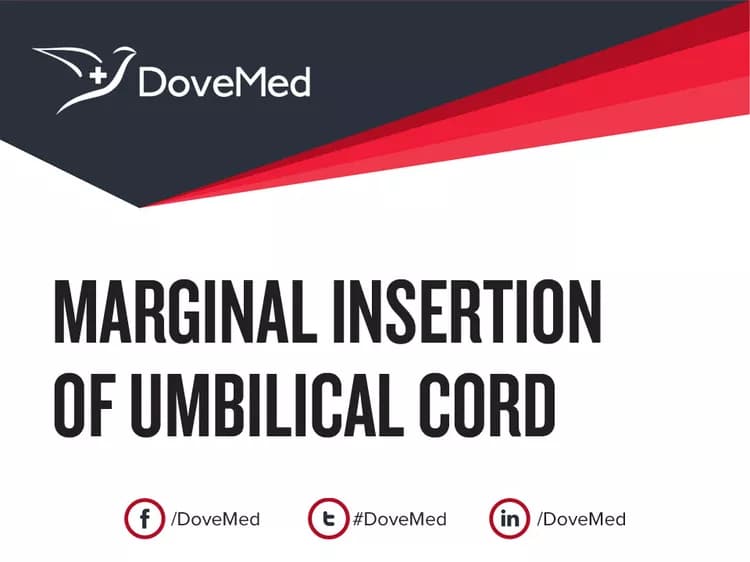What are the other Names for this Condition? (Also known as/Synonyms)
- Battledore Cord Insertion
- Battledore Placenta
- Marginal Umbilical Cord Insertion
What is Marginal Insertion of Umbilical Cord? (Definition/Background Information)
- In approximately 90% of the placentas, the umbilical cord inserts normally, either into the central portion of the placental disc, or is off-centered (in an eccentric manner)
- In Marginal Insertion of Umbilical Cord, the umbilical cord inserts into the edge of the placental disc of the developing fetus (the umbilical cord lies within 2 cm of the placental disc edge)
- There are no causative factors associated with Marginal Insertion of Umbilical Cord. However, twin and multiple pregnancies are some of the risks for the condition
- The signs and symptoms of Marginal Insertion of Umbilical Cord may include excessive hemorrhage during childbirth and decreased blood supply to the fetus, which may affect fetal growth and development
- The condition may be diagnosed by a physical examination, evaluation of complete medical history, and an ultrasound scan of the abdomen
- Marginal Insertion of Umbilical Cord requires no treatment and the outcome is generally good in a majority of cases. However, complications can develop which may be avoided through an elective C-section delivery
- Presently, Marginal Umbilical Cord Insertion is a condition that cannot be prevented
Who gets Marginal Insertion of Umbilical Cord? (Age and Sex Distribution)
- Marginal Insertion of Umbilical Cord occurs in about 7% of all pregnancies. It may occur in pregnant women of all ages
- Women who are pregnant with both male and female fetuses can be affected
- There is no racial, ethnic, or geographical predilection observed
What are the Risk Factors for Marginal Insertion of Umbilical Cord? (Predisposing Factors)
The risk factors for Marginal Insertion of Umbilical Cord include:
- The condition is more common in twin and multiple pregnancies than a single pregnancy
It is important to note that having a risk factor does not mean that one will get the condition. A risk factor increases ones chances of getting a condition compared to an individual without the risk factors. Some risk factors are more important than others.
Also, not having a risk factor does not mean that an individual will not get the condition. It is always important to discuss the effect of risk factors with your healthcare provider.
What are the Causes of Marginal Insertion of Umbilical Cord? (Etiology)
- The exact cause of Marginal Insertion of Umbilical Cord is unknown
- However, some researchers believe that an abnormal development of the placental tissue may result in the condition
What are the Signs and Symptoms of Marginal Insertion of Umbilical Cord?
The signs and symptoms of Marginal Insertion of Umbilical Cord may include:
- Excessive hemorrhage/bleeding during childbirth
- Blood vessel compression
- Decreased blood flow to the fetus
The marginal insertion may be observed on an ultrasound scan.
How is Marginal Insertion of Umbilical Cord Diagnosed?
The diagnosis of Marginal Insertion of Umbilical Cord may involve:
- Physical examination along with an evaluation of one’s medical history
- Prenatal ultrasound scan may reveal the insertion
Many clinical conditions may have similar signs and symptoms. Your healthcare provider may perform additional tests to rule out other clinical conditions to arrive at a definitive diagnosis.
What are the possible Complications of Marginal Insertion of Umbilical Cord?
Complications due to Marginal Insertion of Umbilical Cord may include:
- Preterm birth
- A Marginal Cord Insertion may cause a decrease in blood flow to the developing fetus. This can result in intrauterine growth retardation (IUGR) and other congenital abnormalities in the developing fetus
- Studies have shown that some pregnancies end-up in spontaneous abortions, either in the 1st or 2nd trimester
- Excessive hemorrhage/bleeding during childbirth can result in fetal mortality
- Compression of the blood vessels can cause fetal distress
- If the marginal insertion is present in the cervical outlet of the uterus, they may rupture during early labor. This can result in stillbirth. This condition is known as vasa previa
Note: Generally, the complications of Marginal Cord Insertion are milder than Velamentous Insertion of Umbilical Cord.
How is Marginal Insertion of Umbilical Cord Treated?
- There is no specific treatment available for Marginal Insertion of Umbilical Cord
- Treatment is directed towards managing the fetal complications associated with this condition. Delivery through an elective cesarean section may be necessary to avoid some of the complications
How can Marginal Insertion of Umbilical Cord be Prevented?
- Currently, there are no definitive methods available to prevent Marginal Insertion of Umbilical Cord
- Complications may be avoided during delivery by considering an elective cesarean section (C-section) surgery
What is the Prognosis of Marginal Insertion of Umbilical Cord? (Outcomes/Resolutions)
- In a majority of cases, the prognosis of Marginal Insertion of Umbilical Cord is good
- However, if complications develop, then the prognosis is guarded. In such cases, it is dependent upon the severity of the complications
Additional and Relevant Useful Information for Marginal Insertion of Umbilical Cord:
The following DoveMed website link is a useful resource for additional information:
https://www.dovemed.com/diseases-conditions/pregnancy-related-disorders/
Related Articles
Test Your Knowledge
Asked by users
Related Centers
Related Specialties
Related Physicians
Related Procedures
Related Resources
Join DoveHubs
and connect with fellow professionals


0 Comments
Please log in to post a comment.